|
|
|
Sort Order |
|
|
|
Items / Page
|
|
|
|
|
|
|
| Srl | Item |
| 1 |
ID:
044971
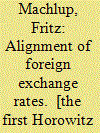

|
|
|
|
|
| Publication |
New York, Preager Publishers, 1972.
|
| Description |
xi, 94p.
|
|
|
|
|
|
|
|
|
|
|
|
Copies: C:1/I:0,R:0,Q:0
Circulation
| Accession# | Call# | Current Location | Status | Policy | Location |
| 009905 | 332.45/MAC 009905 | Main | On Shelf | General | |
|
|
|
|
| 2 |
ID:
111143
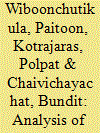

|
|
|
| 3 |
ID:
183776


|
|
|
|
|
| Summary/Abstract |
Foundational theories of trade politics emphasize a conflict between consumer welfare and protectionist lobbies. But these theories ignore other powerful lobbies that also shape trade policy. We propose a theory of trade distortion arising from conflict between consumer welfare and importer lobbies. We estimate the key parameter of the model—the government's weight on welfare—using original data from Venezuela, where Hugo Chávez used an exchange-rate subsidy to underwrite hundreds of billions of dollars of imports. Whereas estimates from traditional models would make Chávez look like a welfare maximizer, our results indicate that he implemented distortionary commercial policy to the benefit of special interests. Our analysis underscores the importance of tailoring workhorse models to account for differences in interest group configuration. The politics of trade policy is not reducible to the politics of protectionism.
|
|
|
|
|
|
|
|
|
|
|
|
|
|
|
|
| 4 |
ID:
178580
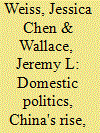

|
|
|
|
|
| Summary/Abstract |
With the future of liberal internationalism in question, how will China's growing power and influence reshape world politics? We argue that views of the Liberal International Order (LIO) as integrative and resilient have been too optimistic for two reasons. First, China's ability to profit from within the system has shaken the domestic consensus in the United States on preserving the existing LIO. Second, features of Chinese Communist Party rule chafe against many of the fundamental principles of the LIO, but could coexist with a return to Westphalian principles and markets that are embedded in domestic systems of control. How, then, do authoritarian states like China pick and choose how to engage with key institutions and norms within the LIO? We propose a framework that highlights two domestic variables—centrality and heterogeneity—and their implications for China's international behavior. We illustrate the framework with examples from China's approach to climate change, trade and exchange rates, Internet governance, territorial sovereignty, arms control, and humanitarian intervention. Finally, we conclude by considering what alternative versions of international order might emerge as China's influence grows.
|
|
|
|
|
|
|
|
|
|
|
|
|
|
|
|
| 5 |
ID:
141692
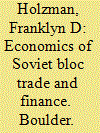

|
|
|
|
|
| Publication |
Boulder, Westview Press, 1987.
|
| Description |
xi, 215p.hbk
|
| Standard Number |
0813372747
|
|
|
|
|
|
|
|
|
|
|
|
Copies: C:1/I:0,R:0,Q:0
Circulation
| Accession# | Call# | Current Location | Status | Policy | Location |
| 029351 | 382.0947/HOL 029351 | Main | On Shelf | General | |
|
|
|
|
| 6 |
ID:
162650
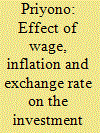

|
|
|
|
|
| Summary/Abstract |
The purpose of this study is to know and analyze the effect of wage variables on regional investment policy, the influence of inflation variables on regional investment policy, and the influence of exchange rate variables on investment policy of the Region on Labor. In this study, the population taken is the entire workforce whose data comes from the Central Bureau of Statistics in Sidoarjo which amounted to 64,792 workers. Data analysis using multiple linear regressions with the help of SPSS program version 20 showed that there is an influence of wages, inflation, and exchange rate on local investment policy. Based on the results of calculations and test results conducted, it can be explained that there is an effect of wages on regional investment of labor followed by the characteristics of inflation on labor that affects the exchange rate of investment. This illustrates for policymakers which empirical evidence exists in a series of time to test the theoretical basis while establishing fiscal, monetary, or exchange rate policies to stabilize output and employment by using interest rates, money supply, and exchange rates as instruments for achieving goals.
|
|
|
|
|
|
|
|
|
|
|
|
|
|
|
|
| 7 |
ID:
152808


|
|
|
|
|
| Summary/Abstract |
This article aims to study the relationship between real effective exchange rate (REER) and international reserve in India by applying the bivariate and conditional bivariate Granger causality test in frequency domain framework proposed by Breitung and Candelon (2006). The variables that are included to condition the frequency domain are the industrial production index, stock prices and wholesale producer index. Results found the evidence of business cyclical causality running from international reserve to REER for frequencies between 0.01 and 1.63 that corresponds to the 4 months and higher months cycles in India. The results have a strong bearing on the policy implications of India and any country alike it. The study concludes that the Reserve Bank of India should consider exchange rate as a grave determinant to manage appropriate forex reserve.
|
|
|
|
|
|
|
|
|
|
|
|
|
|
|
|
| 8 |
ID:
131503
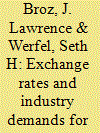

|
|
|
|
|
| Publication |
2014.
|
| Summary/Abstract |
The recent confrontation between China and the United States over currency policy illustrates a broader phenomenon: exchange-rate misalignments tend to spill over into trade policy. Although previous studies have shown that aggregate protectionist activity is positively related to the level of the real effective exchange rate, we explore this relationship at the industry level. Several industry-specific characteristics determine the protectionist response to exchange rate changes, including the degree of exchange-rate pass-through, the level of import penetration, and the share of imported intermediate inputs in total industry inputs. We find that the marginal effect of currency appreciation on the number of industry-level antidumping petitions is positive and significant only for industries with high pass-through. Therefore, exchange rates appear to induce demands for trade barriers only in industries where competitiveness is directly harmed by currency appreciation.
|
|
|
|
|
|
|
|
|
|
|
|
|
|
|
|
| 9 |
ID:
096228
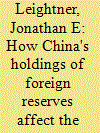

|
|
|
|
|
| Publication |
2010.
|
| Summary/Abstract |
By January 2009, China held almost US$2tn in foreign reserves. The present paper estimates the marginal effect of China changing its holdings of foreign reserves on the value of the US dollar in Europe and Asia. Because using traditional techniques to find this estimate would be inappropriate due to severe problems resulting from omitted variables, the present paper uses a new approach, bidirectional-reiterative truncated projected least squares, that has been proven to minimize problems associated with omitted variables. It is found that if China would sell 1 percent of its foreign reserves, then the value of the US dollar would fall by 0.44 percent. With such a large effect, China has an incentive to either not sell any of its US dollar reserves or sell all of its US dollar reserves.
|
|
|
|
|
|
|
|
|
|
|
|
|
|
|
|
| 10 |
ID:
108025


|
|
|
| 11 |
ID:
116481
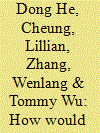

|
|
|
|
|
| Publication |
2012.
|
| Summary/Abstract |
In this paper we study the determinants of gross capital flows, project the size of China's international investment position in 2020, and analyze the implications for the renminbi real exchange rate if China liberalizes the capital account. We assume in this exercise that the renminbi will have largely achieved capital account convertibility by the end of the current decade, a timetable consistent with recent proposals by the People's Bank of China. Our analysis shows that if the capital account were liberalized, China's gross international investment position would grow significantly, and inflows and outflows would become much more balanced. The private sector would turn its net liability position into a balanced position, and the official sector would reduce its net asset position significantly, relative to the country's GDP. Because of the increasing importance of private sector foreign claims and the decreasing importance of official foreign reserves, China would be able to earn higher net investment income from abroad. Overall, China would continue to be a net creditor, with the net foreign asset position as a share of GDP remaining largely stable through this decade. These findings suggest that the renminbi real exchange rate would not be particularly sensitive to capital account liberalization as capital flows are expected to be two-sided. The renminbi real exchange rate would likely be on a path of moderate appreciation as China is expected to maintain a sizeable growth differential with its trading partners.
|
|
|
|
|
|
|
|
|
|
|
|
|
|
|
|
| 12 |
ID:
172368


|
|
|
|
|
| Summary/Abstract |
Indonesia fielded shocks due to the Asian Financial Crisis (AFC) and the Global Financial Crisis (GFC) quite differently. Financial contagion, policy misdirection, panic and political upheaval saw the AFC bring economic collapse. The GFC, however, brought about real domestic growth of 6.1 per cent (2008) and 4.5 per cent (2009)—amongst the world’s best performances at the time. This paper reviews these events and employs numerical modelling of stylized AFC and GFC shocks to show that some of the contrast stems from differences in the shocks and intervening changes in Indonesia’s economic structure. Critically, IMF conditionality during the AFC required unsustainably contractionary reforms. Capital flight elements were present in both crises, however, and exchange rate depreciations and money-financed fiscal expansions are shown to have contributed significantly to resolution.
|
|
|
|
|
|
|
|
|
|
|
|
|
|
|
|
| 13 |
ID:
181395
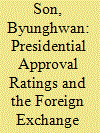

|
|
|
|
|
| Summary/Abstract |
Do presidential approval ratings affect exchange rates? The empirical purview of the vast literature on this topic has been confined to the run-up to elections. The importance of approval ratings in non-election periods has therefore been under-studied. Examining daily data on the exchange rate of the Korean won during the presidency of Park Geun Hye, we find that the won weakened (1) when Park’s ratings were low and (2) when they bounced back unexpectedly from a low level. This finding explains why Park’s impeachment did not lead to a serious panic in the won market. It seems that well before the impeachment, the exchange rate already reflected the market’s concerns about the uncertainty in the government.
|
|
|
|
|
|
|
|
|
|
|
|
|
|
|
|
| 14 |
ID:
161810


|
|
|
|
|
| Summary/Abstract |
This study investigates the impact of rising wage and the appreciation of the yuan on the structure of China's exports. China's exports are classified here as ordinary exports (OE), and two distinctive groups of processing exports, pure assembly exports (PAE) and mixed assembly exports (MAE). The data analyzed here are derived from panel data covering China's bilateral PAE and MAE with 120 trading partners from 1993 to 2013. The estimates of fixed effect models show that wage increase and the appreciation of the yuan reduced the proportion of assembly exports in China's bilateral exports. Specifically, for a 10% increase in Chinese manufacturing wages, the share of PAE in China's bilateral exports is expected to fall 4.59% and that of MAE to decrease 0.9%; and a 10% nominal appreciation of the yuan against the US dollar is expected to lower the shares of PAE and MAE 8.56% and 7.26% respectively. The empirical results imply that rising wage and cumulative appreciation of the yuan have eroded China's comparative advantage in the assembly of products for international markets, resulting in substantial contraction of assembly exports. The analysis provides a supply-side explanation for the fall of China's export growth.
|
|
|
|
|
|
|
|
|
|
|
|
|
|
|
|
| 15 |
ID:
147629
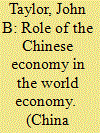

|
|
|
|
|
| Summary/Abstract |
In this paper I first review the amazing progress that free market economic reforms have brought to the Chinese people after years of central control and suppression of markets. Thanks to greater economic freedom, economic growth increased sharply and hundreds of millions of people have been removed from poverty. By all accounts, however, economic freedom in China has a long way to go. The U.S. perspective should be that these market reforms continue. These further reforms toward economic freedom and economic growth in China will be beneficial to the United States. Such reforms would include a greater transparency about the monetary policy strategies, more openness of the capital accounts and less exchange rate and stock market intervention. Such economic reforms should be welcomed and encouraged by the United States and other countries.
|
|
|
|
|
|
|
|
|
|
|
|
|
|
|
|
| 16 |
ID:
147443


|
|
|
|
|
| Summary/Abstract |
The departure of a factor in excess supply in a non-traded rural sector leads to a Rural-led Exchange Rate Real Appreciation (RERA), in a dual economy setup. The RERA highlights for the first time a potential link between intra-national factor movements and real exchange rates. In China, where there is excess labor employed in the production of (largely) non-traded rural goods, we attribute around one third of the recent appreciation of the real exchange rate – defined as the relative price of nontradables – to a RERA effect.
|
|
|
|
|
|
|
|
|
|
|
|
|
|
|
|
| 17 |
ID:
116502


|
|
|
|
|
| Publication |
2012.
|
| Summary/Abstract |
This paper examines how China's exports are affected by exchange rate shocks from countries that supply intermediate inputs to China. We build a simple small open economy model with intermediate goods trade to show that due to the intra-regional trade in intermediate goods, a devaluation of other Asian currencies does not necessarily hurt China's exports, as imported intermediate goods could become cheaper. The effect of intermediate goods costs depends critically on the share of intermediate goods used in China's export goods production and the degree of exchange rate pass-through in imported intermediate goods prices. If prices for intermediate goods are not very sticky, the effect through this channel could be large, and China's exports could even benefit. We find that these findings do not depend on China's choice of currency invoicing between the RMB and the US dollar or the choice between fixed and flexible exchange rate regimes.
|
|
|
|
|
|
|
|
|
|
|
|
|
|
|
|
|
|
|
|
|